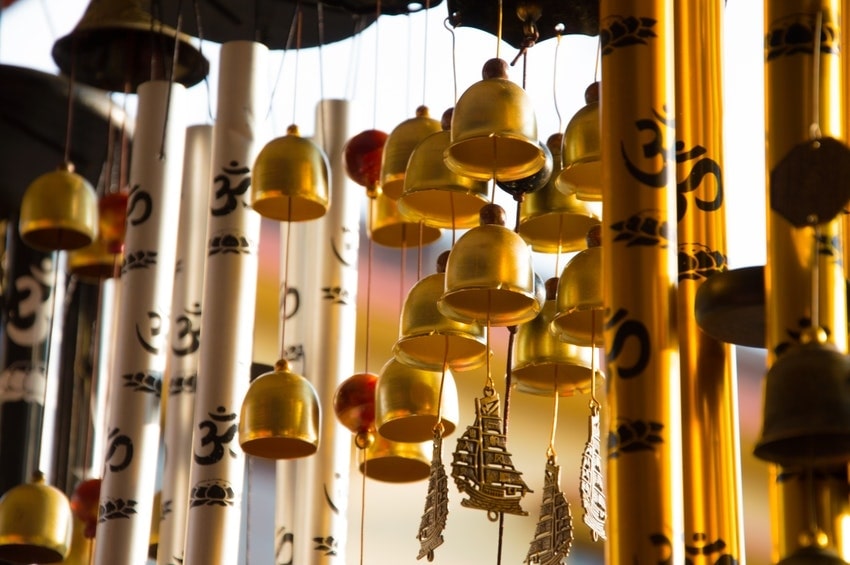The Origin Story of Wind Chimes
Wind chimes are one of those things we’re all familiar with but whose origins are somewhat mysterious. The fact is the metal wind chimes we know today are the result of thousands of years of history and refinement and tend to reflect an amalgamation of cultural influence that span the globe. In this piece, we're going to examine the long and fascinating history of the wind chime.
Origins
Wind chimes are an offshoot of bells, which first appear in the archeological record around 3000 BC in Southeast Asia. It took a while, but bells eventually spread throughout Asia, and by around 1100 BC the Chinese were hanging small bells - which they called “feng ling” - in the wind and enjoying the sounds they created.
It wasn’t long before Buddhists in particular began to use iron wind chimes of different sizes and shapes in and around their temples to create a pleasing natural symphony and to ward off evil spirits. Just where the idea that they could be used as a defense against evil spirits originated is impossible to determine, though there are many who believe that the well-known ability of bell chimes to scare off birds led to the belief they could be used to ward off spirits.
Parallel Developments
It wasn’t long before wind bells from China found their way to Japan, where they were quickly adopted. The Japanese came to call them “furin”, which is a literal translation of “wind bell”. Because the Japanese at the time believed in their own version of “mal-aria” (bad air), they employed wind chimes outside temples and other important buildings to ward off airborne disease.
In Southeast Asia, where bells are thought to have originated, various tribes developed their own version of the wind chime. In Bali, for instance, large pieces of bamboo would be dried and then hung next to each other in the wind to create subtle but very beautiful tones as they bounced off one another. These bamboo wind chimes would eventually inspire the development of tubular metal wind chimes.
Over the centuries wind tubes and wind bells spread throughout Asia and became a cultural staple. Today, wind chimes omnipresent in the Buddhist temples of Thailand, Cambodia and Myanmar as well as the Hindu temples of India, where bell-shaped chimes are still extremely common.
Roman Adoption
On the other side of the world, the ancient Romans had established trade relations with the people of what is now India more than 2,000 years ago, and it is likely that traders brought wind chimes from the subcontinent back to Rome with them. The Romans gave iron wind chimes their own unique spin, creating what became known as “tintinnabulum”.
In time nearly all tintinnabulum were cast from bronze and took on an overtly sexualized appearance thought to be a harbinger of fertility and good luck. Romans quickly grew fond of tintinnabulum and hung them outside of bedroom windows and in their gardens (again to ward off birds). Some Romans hung them on the inside of doors to alert homeowners that someone had entered. While others made the leap to using them as de facto doorbells by attaching them to a cord that hung outside the front door which could be pulled by the visitor.
Many of these phallic Roman wind chimes have survived to this day and can be seen in various museums throughout the Western world.
The Pendulum Swings Back East
One more note while we’re on the subject of cultural cross-pollination: Earlier we mentioned how Chinese wind bells had been adopted by the Japanese, rebranded “furin” and used to ward off airborne disease. Well, in the 18th century the Japanese first came into contact with glass by way of Dutch merchants. The Japanese quickly fell in love with this new material and began producing glass versions of furin that are still extremely popular today.
As you can see the modern wind chime is the result of the push and pull of culture and trade over many centuries. Crude bells first emerged in Southeast Asia and spread north to China where they were hung in the wind. These wind bells became popular in India where ancient Roman traders acquired them and brought them back to Europe where they evolved into tintinnabulum. Centuries later glass blowing technology from Europe was brought back East to Japan and influenced the development of an entirely new type of wind chime.
Iron, Glass and Metal Wind Chimes from Paykoc Imports
At Paykoc Imports, we offer scores of beautiful, evocative, compelling wind chime designs and configurations that reflect the long history of these amazing objects and satisfy every taste and need. From vibrant but simple Sun Face metal wind chimes to our elaborate Golden Buddha wind chime and our Geometric iron wind chimes there is something for every person and every setting.
Keep in mind that there’s no need to venture out to our Denver brick and mortar shop in order to avail yourself of our vast wind chime collection. All of our products, including our wind chimes, are available via our extensive, convenient online shop. Bear in mind, too, that if you have a shop and wish to feature wind chimes you can purchase them wholesale from Paykoc. To discuss the matter with one of our sales agents email our team at paykocimports@gmail.com or call 1-888-657-2881.

 Default Currency
Default Currency
